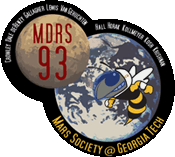Radio-based Voice and Data Communication Research Plan
This proposal seeks to continue the effort of Crew 79 by providing reliable communications between an EVA team and its base. Crew 93 will use prior studies from past crews to determine what worked well and what fell short of the MDRS crew needs. This crew will attempt to improve the communication system previously established by ensuring power is maintained and also experimenting with placement of equipment and its range.
Based on the experience gained from these prototypes, Crew 93 will use the same set-up as Crew 79 in order to correct previous issues and establish a reliable communication system. Interviews held with members of previous missions will outline the needs for modification of the communication system. Aspects of the system that performed well will be kept in the new system as much as possible unless, through the course of a redesign, an improved method is found. The interviews will also allow mission members to provide useful insights and input into the redesign so that their needs and desires are included.
This crew will test links established between Kenwood TH-D7A APRS enabled radios and attached GPS units on each space suit, a pair of deployable APRS and voice repeaters using a Kenwood TM-D700A for the digital repeater, and two Icom IC-W32A radios for a cross band repeater. Figure 1 diagrams the previous and current system. The system, as designed, will help establish improved surveying and mapping missions of the terrain through the automatic position reports forwarded to the habitat module via the APRS data links. Figures 2 and 3 show the mapping possible, especially with the combination of the data and Google Earth in Figure 3.
No additional radio equipment is necessary, however, a voltmeter will be secured in order to keep a log of battery power to ensure power is not lost during an extra-vehicular excursion (EVA). Interviews with past crew members indicated that equipment had failed due to a lack of necessary power. The goal is to have less dependence on only battery power, which requires an exploration team to retrieve the batteries at regular intervals for charging. A combination solar and battery power system will be constructed to provide long service time for the repeater. A solar panel from the Hab will be used to aid this generation of power on the hilltop. Battery power will be tracked and recharged as needed.
As seen in the past, placement and power supplies may limit operation and range. The digipeater will be placed strategically and range will be measured to see how far the explorers can go before communication is lost. Equipment may be moved to different locations for testing. This will provide data for future missions.
Sponsorship was secured in past years with the Kenwood Corporation, Amateur Radio division, which produces the TM-D7A handheld and TM-D700 mobile data radio. These units have been used at MDRS in the past, and are directly compatible with the Amateur Packet Reporting System (APRS) as designed by Robert Bruninga, WB4APR, of the United States Naval Academy. The Kenwood radios and APRS system has seen extensive use at MDRS during several crews for tracking of EVA teams, digital messaging and voice communication.
The APRS protocol allows for arbitrary data transfer formats in addition to position and message formats. This is suitable for adding telemetry devices in the field that can report back to the mission members and beyond. Some remote sensors suggested for use are sunlight intensity sensors, temperature sensors, and radiation sensors. These can be interfaced to the APRS system by way of an OpenTracker APRS telemetry interface from Argent Data Systems, a BASIC Stamp from Parallax (if needed by the sensor to digitize the data), and an inexpensive handheld radio such as the Kenwood TH-K2AT. Together, a full one-way telemetry system can be added to the many tools available to mission members for remotely monitoring their environment.

1. Radiocommunications system based on Amateur Radio

2. Surveying and Mapping

3. Visualization in Google Earth

No comments:
Post a Comment